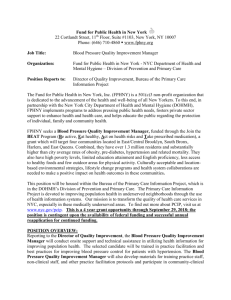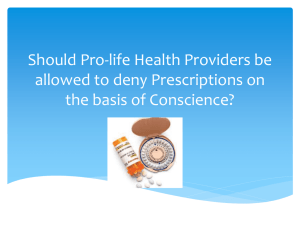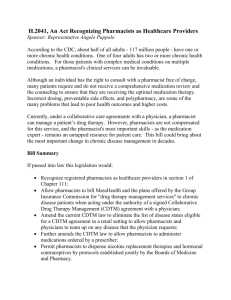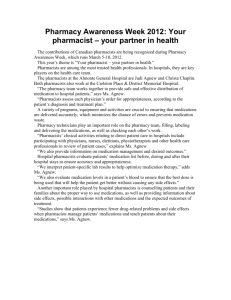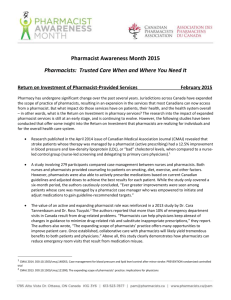February-HUB-2015
advertisement
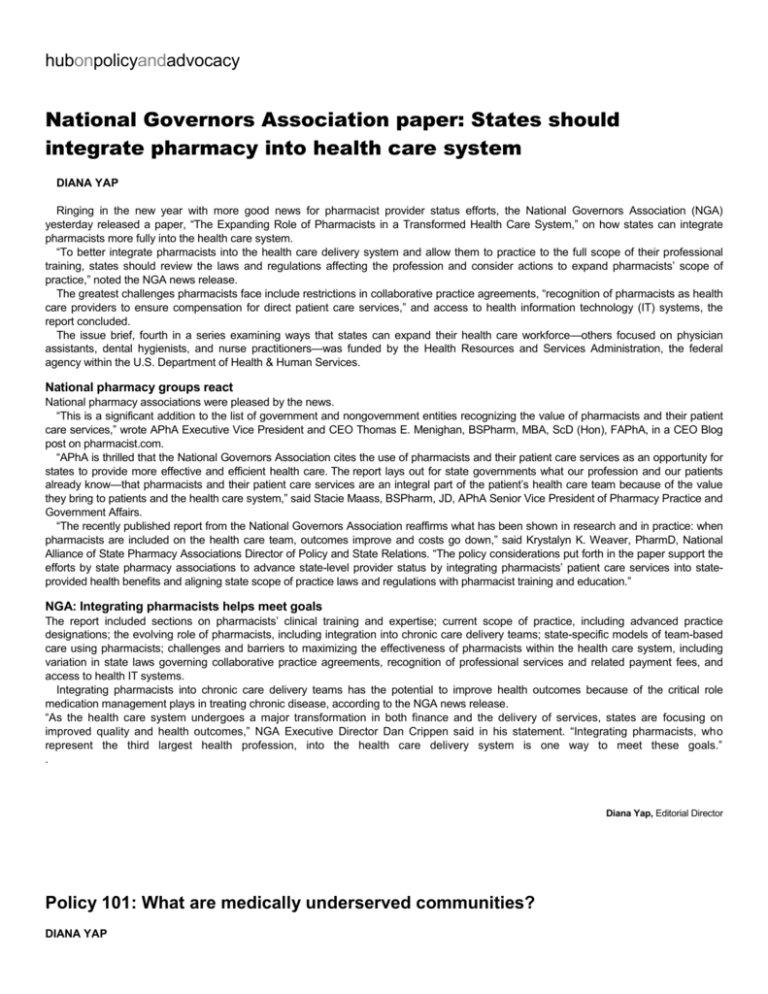
hubonpolicyandadvocacy National Governors Association paper: States should integrate pharmacy into health care system DIANA YAP Ringing in the new year with more good news for pharmacist provider status efforts, the National Governors Association (NGA) yesterday released a paper, “The Expanding Role of Pharmacists in a Transformed Health Care System,” on how states can integrate pharmacists more fully into the health care system. “To better integrate pharmacists into the health care delivery system and allow them to practice to the full scope of their professional training, states should review the laws and regulations affecting the profession and consider actions to expand pharmacists’ scope of practice,” noted the NGA news release. The greatest challenges pharmacists face include restrictions in collaborative practice agreements, “recognition of pharmacists as health care providers to ensure compensation for direct patient care services,” and access to health information technology (IT) systems, the report concluded. The issue brief, fourth in a series examining ways that states can expand their health care workforce—others focused on physician assistants, dental hygienists, and nurse practitioners—was funded by the Health Resources and Services Administration, the federal agency within the U.S. Department of Health & Human Services. National pharmacy groups react National pharmacy associations were pleased by the news. “This is a significant addition to the list of government and nongovernment entities recognizing the value of pharmacists and their patient care services,” wrote APhA Executive Vice President and CEO Thomas E. Menighan, BSPharm, MBA, ScD (Hon), FAPhA, in a CEO Blog post on pharmacist.com. “APhA is thrilled that the National Governors Association cites the use of pharmacists and their patient care services as an opportunity for states to provide more effective and efficient health care. The report lays out for state governments what our profession and our patients already know—that pharmacists and their patient care services are an integral part of the patient’s health care team because of the value they bring to patients and the health care system,” said Stacie Maass, BSPharm, JD, APhA Senior Vice President of Pharmacy Practice and Government Affairs. “The recently published report from the National Governors Association reaffirms what has been shown in research and in practice: when pharmacists are included on the health care team, outcomes improve and costs go down,” said Krystalyn K. Weaver, PharmD, National Alliance of State Pharmacy Associations Director of Policy and State Relations. “The policy considerations put forth in the paper support the efforts by state pharmacy associations to advance state-level provider status by integrating pharmacists’ patient care services into stateprovided health benefits and aligning state scope of practice laws and regulations with pharmacist training and education.” NGA: Integrating pharmacists helps meet goals The report included sections on pharmacists’ clinical training and expertise; current scope of practice, including advanced practice designations; the evolving role of pharmacists, including integration into chronic care delivery teams; state-specific models of team-based care using pharmacists; challenges and barriers to maximizing the effectiveness of pharmacists within the health care system, including variation in state laws governing collaborative practice agreements, recognition of professional services and related payment fees, and access to health IT systems. Integrating pharmacists into chronic care delivery teams has the potential to improve health outcomes because of the critical role medication management plays in treating chronic disease, according to the NGA news release. “As the health care system undergoes a major transformation in both finance and the delivery of services, states are focusing on improved quality and health outcomes,” NGA Executive Director Dan Crippen said in his statement. “Integrating pharmacists, who represent the third largest health profession, into the health care delivery system is one way to meet these goals.” . Diana Yap, Editorial Director Policy 101: What are medically underserved communities? DIANA YAP Federal provider status recognition legislation was introduced as H.R. 4190 in the last Congress by Reps. Brett Guthrie (R-KY), G.K. Butterfield (D-NC), and Todd Young (R-IN) on March 11, 2014, and is expected to be reintroduced—with a new bill number—in this Congress. The legislation would amend Title XVIII of the Social Security Act to enable patient access to, and coverage for, Medicare Part B services by all state-licensed pharmacists who practice in “medically underserved communities.” What are medically underserved communities? The legislation specifically references Medically Underserved Areas (MUAs), Medically Underserved Populations (MUPs), or Health Professional Shortage Areas (HPSAs), which are defined and designated by the Health Resources and Services Administration (HRSA) in the U.S. Department of Health & Human Services. Pharmacists can find out if they practice in an MUA, MUP, or HPSA on the HRSA website (http://datawarehouse.hrsa.gov/GeoAdvisor/ShortageDesignationAdvisor.aspx). Shortage designation: Combination of factors The HRSA designations aren’t just about not enough physicians. Rather, they are the result of a combination of factors, according to the HRSA website (www.hrsa.gov/shortage/). MUAs and MUPs are areas or populations that have too few primary care providers, high infant mortality, high poverty, and/or high older adult population. In MUAs—including a whole county, a group of contiguous counties, a group of county or civil divisions, or a group of urban census tracts—residents have a shortage of personal health services. MUPs may include groups of persons within an area of residence who face economic, cultural, or linguistic barriers to health care. HPSAs have shortages of primary medical care, dental, or mental health providers and may be geographic (a county or service area), demographic (low-income population), or institutional (comprehensive health center, federally qualified health center, or other public facility). In short, HPSAs may be urban or rural areas, population groups, or medical or other public facilities. Medically underserved communities aren’t just very remote or rural. Many areas throughout the country, including inner-city urban areas, fall into MUAs, MUPs, and HPSAs. The areas so designated will likely increase as the shortage of primary care providers worsens as projected. Practicing in an underserved community El Rio Health Center—which serves the greater Tucson area and southern Arizona with 18 locations—is located in an area that HRSA designates as MUA, MUP, and HPSA (primary care, as well as mental health and dental provider shortages). “As health care continues to shift to outcomes-driven care, it is especially critical to have access to care for patients to hit quality outcomes, goals, and safety,” said Sandra Leal, PharmD, MPH, Vice President for Innovation at SinfoniaRx, former Medical Director of Clinical Pharmacists/Broadway Clinic at El Rio, and a longtime advocate for pharmacist provider status. “This legislation is critical for us because pharmacists can help fill gaps in care to improve access to care for patients,” said Leal. “This legislation will create opportunities for pharmacists to help alleviate the shortages that are currently happening in HPSA areas and MUA areas. Some of these areas are in remote rural areas where pharmacists are sometimes one of the few providers available to help patients.” Health Partners of Western Ohio (HPWO) has four locations that are designated as primary care, mental health, and dental MUA, MUP, and HPSA, said Jenny Clark, BSPharm, HPWO Director of Pharmacy Services. “With Medicaid expansion in Ohio and patients getting insurance through the marketplace, more patients are presenting for care at a time when there are fewer primary care providers to meet their needs,” Clark said. “We are in medically underserved areas, so most of the time we don’t have physicians. We’re dealing with mostly nurse practitioners and physician assistants. So pharmacists are really able to integrate into the team,” said Josh Ebbing, PharmD, a clinical pharmacist at one of the clinics. “This legislation is vital to continue our incorporation into the health care team.” “At our organization, we have people come in who have not seen a family provider in over 20 years, due to the lack of care in the community in which they live. This legislation would allow more patients the opportunity to get the care that they have been missing out on for a long time,” said Kyle Glasgow, PharmD, BCACP, a Clinical Pharmacy Manager and Residency Coordinator at another of the clinics. “Practicing with this community, it really allows you to form a unique bond with your patient because a lot of these patients have been failed so many other times in their lives,” Glasgow continued. “Once they do open up to you, it’s amazing how much they show you what you mean to them; how appreciative they are that they finally have a group of people who care about them. It makes it easy to go to work every day knowing the impact you can have on somebody’s life.” Diana Yap, Editorial Director Disease state management provided at FQHC in North Carolina SONYA COLLINS “Mary’s” physician had tried several different medications for her hard-to-control diabetes. While one medication would cause intolerable adverse effects, another would have no impact on her disease state at all. Mary couldn’t lose weight, her blood pressure was out of control, and her glycosylated hemoglobin (A1C) wouldn’t budge below 8.7. That’s when Mary’s physician referred her to clinical pharmacist practitioner Jennifer Smith, PharmD. Physicians simply do not have sufficient time to provide the amount of education that patients need to live successfully with diabetes and other chronic conditions. Fortunately, under North Carolina’s collaborative practice agreement, the state medical board authorizes Smith to provide disease state management to patients with a number of conditions at Wilson Community Health Center, a federally qualified health center (FQHC) in Wilson, NC. In the hour she spends with patients with diabetes, Smith has the time to learn about any possible barriers to patients’ reaching their treatment goals. But Smith can’t always address those barriers. “Where my hands are tied is that I can’t provide comprehensive care to patients that receive Medicaid or Medicare,” she said. Patient access to comprehensive care? Because CMS does not recognize pharmacists as health care providers, as other stories in this series show, Smith cannot always give patients the comprehensive care that the state medical board authorizes her to provide. Yet in a federally qualified health center where a significant portion of the patient population is living with chronic disease that is controlled with chronic medication, pharmacists could greatly ease the burden on physicians, who are already in short supply and high demand. “Pharmacists are uniquely placed and trained to provide that disease state education and management,” Smith said. Ninety-five percent of the patients the clinic sees live within 200% of the federal poverty level. Sixty percent are uninsured, and most of the others are on Medicare or Medicaid. And 25% have diabetes. Low health literacy and general low literacy mean patients at Wilson Community Health Center need additional guidance in self-management. “Many people might think an hour is way too long, but our patients need it,” Smith said. ‘The patient was so excited’ During a typical diabetes appointment, Smith downloads the data from the patient’s glucose meter. They discuss diet, exercise, and lifestyle changes. She reviews all their medications for drug interactions, redundant medications, and new prescriptions. She adjusts medications as needed. In her appointment with Mary, Smith learned that Mary’s medications weren’t working for her. Because Mary had seen no change in her weight, blood glucose levels, or blood pressure with her medications, she’d lost the motivation to keep trying. When Smith started Mary on a sodium–glucose cotransporter 2 inhibitor, everything changed. “When she had a little bit of weight loss, a drop in blood sugar and blood pressure, she was ecstatic,” Smith said. “So it motivated her to start doing some exercise, because she was just so excited that she was finally starting to lose weight.” Time for teaching patients Smith needed to monitor Mary’s kidney function and potassium levels after she started her new medication. But CMS doesn’t allow pharmacists to monitor patients’ labs, nor can pharmacists order a patient’s diabetes testing supplies. For these common components of diabetes management—that the state medical board authorizes Smith to do—Smith had to track down Mary’s physician. “It takes time away from me, from her provider, and from her,” Smith said, slowing down the momentum that Smith and Mary had gained. This may seem like a minor inconvenience, Smith says, until you multiply that delay in care by the number of adults with a chronic disease. One-half of U.S. adults have at least one chronic disease. More than 12% of adults have two or more chronic diseases. “Physicians have maybe 15 minutes. You’re not going to be able to teach patients disease self-management and address their medication issues, and also examine them and carry out everything else the provider has to do,” Smith said. “Pharmacists could be providing some of those services. We are trained to be disease state educators and medication managers.” Sonya Collins, MA, MFA, contributing writer . Photo Caption: Jennifer Smith

